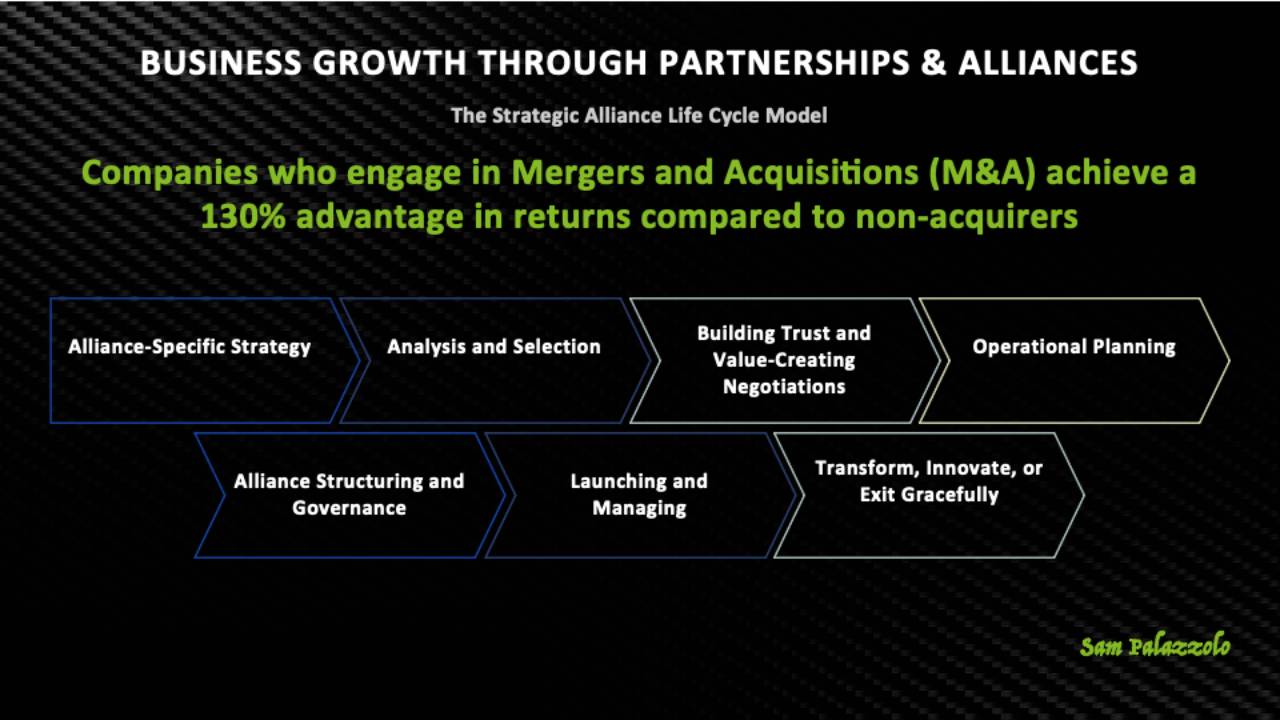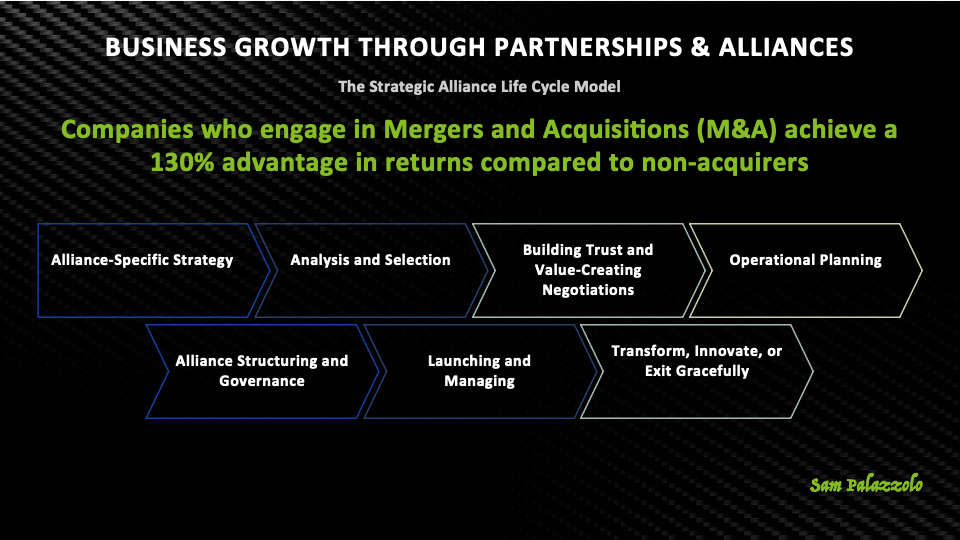The Power of Strategic Partnerships & Alliances: A 7-Stage Framework for Sustainable Growth
Mar 02, 2025
Why Most Business Partnerships Fail—And What to Do About It
In the last two decades, companies have engaged in over $56 trillion worth of M&A deals, with frequent acquirers achieving a 130% higher shareholder return compared to those that don’t pursue strategic alliances. However, many of these partnerships fail to deliver expected value due to poor execution, lack of alignment, and governance gaps.
According to Deloitte, 79% of CEOs plan to increase investments in partnerships over the next three years, yet over half of strategic alliances fail due to:
- Misaligned goals – One party seeks revenue growth, while the other prioritizes brand exposure.
- Poor governance – Decision-making is unclear, leading to stalled initiatives.
- Resource drain – The partnership becomes a distraction rather than a catalyst for success.
Strategic partnerships should not feel like a gamble. Instead, they must follow a structured process to ensure alignment, mitigate risks, and drive sustainable value.
This is where the Strategic Alliance Life Cycle framework comes in—a seven-stage roadmap for building, managing, and optimizing partnerships effectively. Developed by the Association of Strategic Alliance Professionals, this model will help any size organization (SMB to Fortune 500) navigate Strategic Partnerships and Alliances successfully. Let’s get into it…
The 7 Stages of the Strategic Alliance Life Cycle
To build partnerships that drive sustainable success, leaders must follow a structured lifecycle. From strategy development to execution and evolution, these seven stages ensure alignment, governance, and measurable impact.
1. Alliance-Specific Strategy: Aligning Business Goals
Before pursuing a partnership, organizations must define their strategic objectives. This means understanding:
- What problem the alliance will solve.
- How it aligns with broader business goals.
- What success will look like.
Example: A SaaS company looking to scale its enterprise customer base might explore a strategic alliance with a management consulting firm that advises Fortune 500 clients. The SaaS company provides technology, while the consulting firm provides trusted relationships—a mutually beneficial value exchange.
2. Analysis & Selection: Finding the Right Partner
Not all partnerships are created equal. Companies should conduct due diligence to assess potential partners based on:
- Financial health and stability.
- Cultural and operational compatibility.
- Shared long-term vision.
Example: A food tech startup looking for a retail distribution partner must evaluate whether a regional supermarket chain or a national distributor aligns better with its expansion strategy.
3. Building Trust & Value-Creating Negotiations
A partnership’s success depends on mutual trust and a well-structured agreement. This phase involves:
- Clearly defining roles, expectations, and contributions.
- Structuring incentives so both parties benefit.
- Outlining risk-sharing mechanisms.
Example: Apple and IBM formed an alliance where IBM gained access to Apple’s mobile devices for enterprise solutions, while Apple benefited from IBM’s corporate network. Both companies leveraged their strengths for mutual gain.
4. Operational Planning: Laying the Execution Roadmap
Once agreements are in place, leaders must develop a tactical execution plan that includes:
- Defined performance metrics.
- Resource allocation (people, technology, capital).
- Governance structures.
Example: A healthcare provider partnering with a telemedicine startup must establish how patient data will be shared securely, which compliance measures must be met, and how success will be measured in patient engagement.
5. Alliance Structuring & Governance: Ensuring Accountability
Without governance, partnerships can become unstructured and ineffective. To prevent this, companies should:
- Define decision-making frameworks (who approves what).
- Create clear escalation paths for conflict resolution.
- Appoint key alliance managers to oversee execution.
- Establish joint steering committees or advisory boards for alignment.
Example: A pharmaceutical company and biotech startup co-developing a drug need joint steering committees to oversee R&D, intellectual property rights, and regulatory approvals.
6. Launching & Managing: Driving Continuous Performance
A successful launch is just the beginning. Ongoing alliance management requires:
- Frequent check-ins and KPI reviews.
- Adjustments to strategy as market conditions evolve.
- Proactive problem-solving to prevent bottlenecks.
Example: Microsoft’s strategic alliance with OpenAI wasn’t just a one-time deal. The partnership evolved over time, adapting to advances in AI technology and shifting industry needs.
7. Transform, Innovate, or Exit Gracefully
Partnerships are not static. At some point, leaders must evaluate whether to expand, pivot, or exit based on:
- Performance against objectives.
- New market opportunities.
- Shifting industry landscapes.
Example: When Starbucks and PepsiCo partnered for bottled coffee distribution, they scaled aggressively into retail chains worldwide. However, if sales decline or strategies diverge, an exit strategy must be in place.
Key Takeaways: Turning Partnerships into Competitive Advantage
- Strategic partnerships are a critical growth strategy, but only when structured correctly.
- The seven-stage framework ensures partnerships are built for long-term success.
- Governance, performance tracking, and adaptability are essential for sustained value creation.
Real Strategies. Real Results.
The best business leaders don’t enter partnerships blindly. They follow proven frameworks to ensure measurable success.
Want deeper insights into scaling strategies? Subscribe to my newsletter and receive my ‘50 Scaling Strategies’ eBook ($50 Value) for FREE here: sampalazzolo.com
Until next time, scale smarter!
– Sam Palazzolo, Principal Officer @ The Javelin Institute
KEY TAKEAWAYS
- Over 50% of strategic partnerships fail due to misalignment, poor governance, or lack of execution.
- Companies that engage in M&A see a 130% higher shareholder return than those that do not pursue strategic alliances.
- 79% of CEOs plan to increase partnership investments, yet many lack a structured approach to execution.
- The 7-stage Strategic Alliance Life Cycle provides a proven framework to maximize partnership success.
- Successful partnerships require clear alignment, structured governance, and continuous performance tracking.
- A well-defined exit strategy is as important as the initial formation of the alliance.
- Real-world case studies (Apple-IBM, Microsoft-OpenAI, Starbucks-PepsiCo) highlight the impact of strategic alliances.
- Organizations must continuously evaluate their alliances to determine whether to expand, innovate, or exit.
- Strategic partnerships are a powerful competitive advantage when executed with precision and foresight.
SUBSCRIBE FOR WEEKLY BUSINESS SCALING STRATEGIES
REAL STRATEGIES. REAL SOLUTIONS.
We respect your privacy. Unsubscribe at any time.

